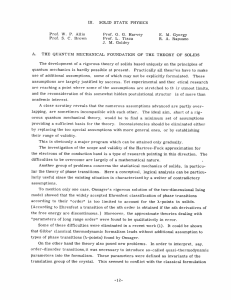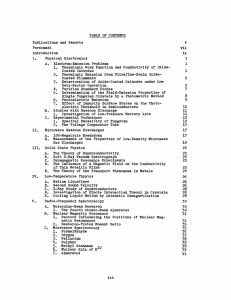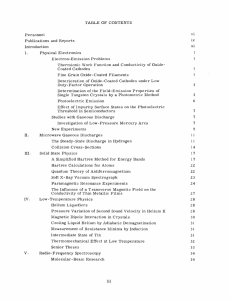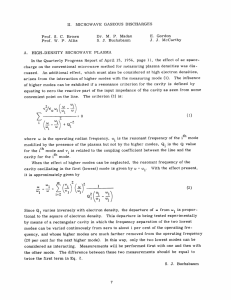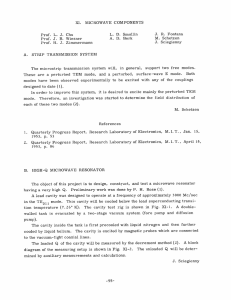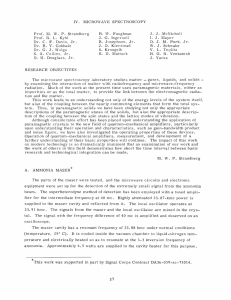Prof. S. C. Brown L. Gould
advertisement
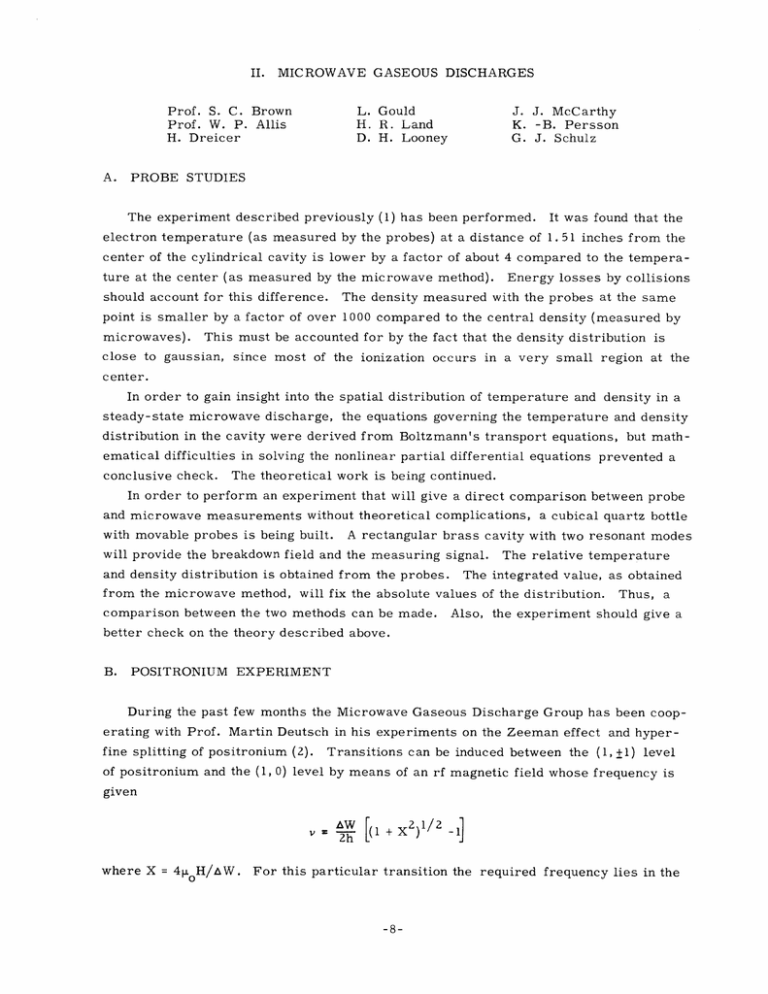
II. A. MICROWAVE GASEOUS DISCHARGES Prof. S. C. Brown Prof. W. P. H. Dreicer Allis L. Gould J. J. McCarthy H. R. Land D. H. Looney K. -B. Persson G. J. Schulz PROBE STUDIES The experiment described previously (1) has been performed. It was found that the electron temperature (as measured by the probes) at a distance of 1. 51 inches from the center of the cylindrical cavity is lower by a factor of about 4 compared to the temperature at the center (as measured by the microwave method). should account for this difference. Energy losses by collisions The density measured with the probes at the same point is smaller by a factor of over 1000 compared to the central density (measured by microwaves). This must be accounted for by the fact that the density distribution is close to gaussian, since most of the ionization occurs in a very small region at the center. In order to gain insight into the spatial distribution of temperature and density in a steady-state microwave discharge, the equations governing the temperature and density distribution in the cavity were derived from Boltzmann's transport equations, but math- ematical difficulties in solving the nonlinear partial differential equations prevented a conclusive check. The theoretical work is being continued. In order to perform an experiment that will give a direct comparison between probe and microwave measurements without theoretical complications, a cubical quartz bottle with movable probes is being built. A rectangular brass cavity with two resonant modes will provide the breakdown field and the measuring signal. and density distribution is obtained from the probes. The relative temperature The integrated value, as obtained from the microwave method, will fix the absolute values of the distribution. comparison between the two methods can be made. Thus, a Also, the experiment should give a better check on the theory described above. B. POSITRONIUM EXPERIMENT During the past few months the Microwave Gaseous Discharge Group has been cooperating with Prof. Martin Deutsch in his experiments on the Zeeman effect and hyperfine splitting of positronium (2). Transitions can be induced between the (1, il) level of positronium and the (1, 0) level by means of an rf magnetic field whose frequency is given AW [( where X = 4 oH/AW. + X) 1 /2 1] For this particular transition the required frequency lies in the -8- (II. MICROWAVE GASEOUS microwave region when H is in the vicinity of 9000 gauss. DISCHARGES) The high-frequency magnetic field must be perpendicular to the steady applied magnetic field. For this experiment a high-Q cavity operating in the TM110 mode was constructed It was made of polished silver- to fit between the pole pieces of a large electromagnet. plated brass with provisions for cooling and magnetic excitation around a design frequency of 3000 Mc/sec. The measured Q of the cavity was about 25, 000. Cavities of other resonant frequencies were also constructed in a similar manner for purposes of checking the theoretically predicted transition frequency. A source of a few millicuries of Cu 64 was electroplated at the center of the remov- able end plate of the cavity to produce the positrons which were confined to a beam of At the center of the cavity the high- approximately 3 cm along the axis of the cavity. frequency magnetic field was directed along the diameter of the cavity, perpendicular to the steady magnetic field, so as to induce the required transitions in the positronium The gases used were freon and argon. formed within the volume of the cavity. The magnitude of the rf field varied between 3 gauss and 15 gauss in amplitude. In early experiments the microwave source of power was a QK-60-series magnetron, and at the power level obtainable with this source the transition line was found to be 3 To increase the resolution of the tran- to 5 times the statistical fluctuation of the data. sition line a Litton JAN-5607, l-kw continuous-wave magnetron was used as the source of microwave power in later experiments with good results. An interesting sidelight of these experiments was the unexpected increase in the amount of positronium formed in the presence of an rf field when argon was used as the gas. Further work on this experiment is contemplated with a cavity that has provision for a magnetic field rotating at the microwave frequency (circularly polarized TM 10 1 mode). References 1. Quarterly Progress Report, Research Laboratory of Electronics, 1952, pp. 10-11 2. M. Deutsch, S. C. Brown: Phys. Rev. -9- 85, 1047, 1952 M. I. T. July 15,

